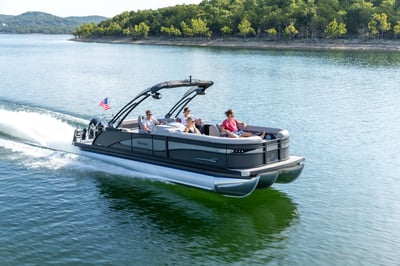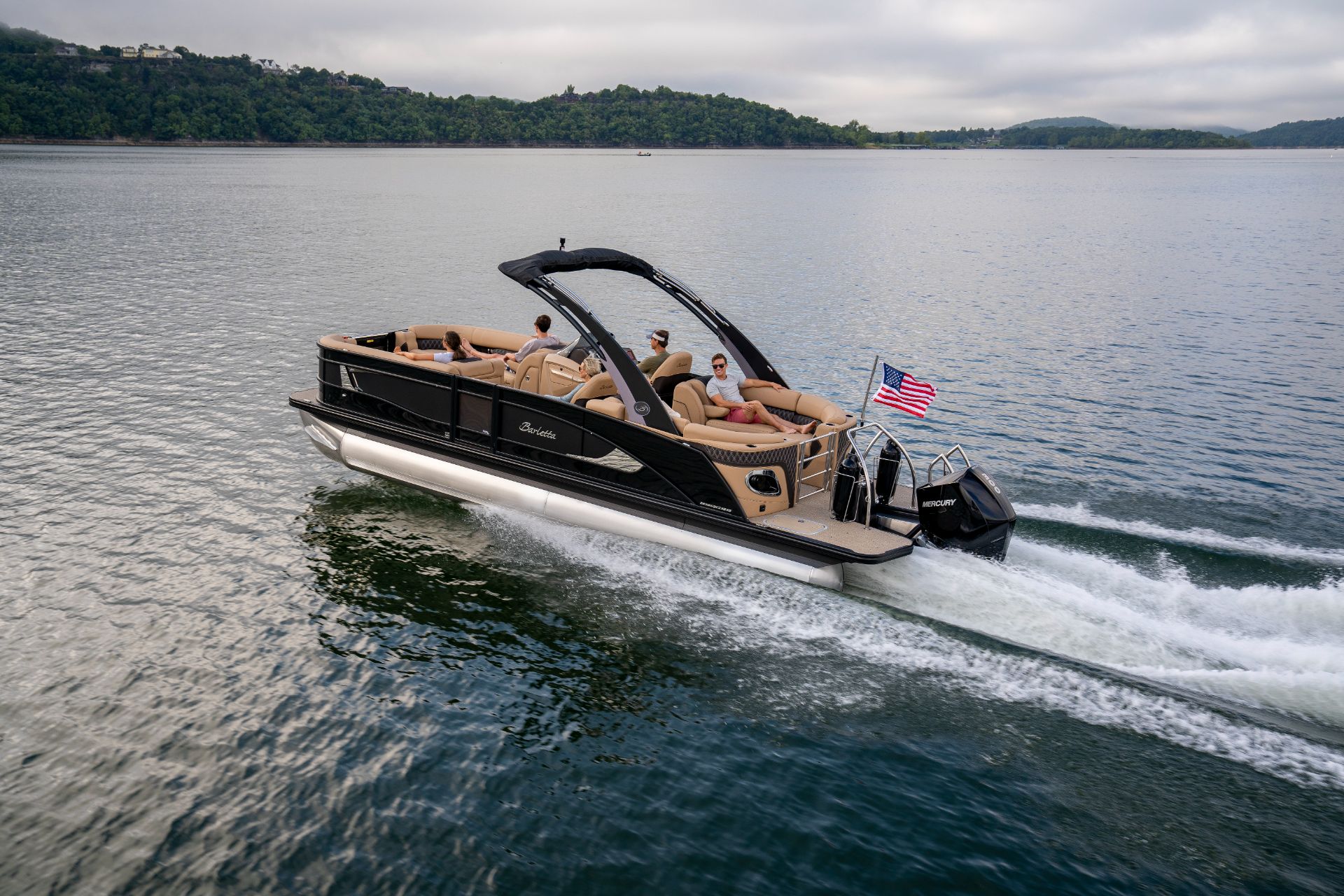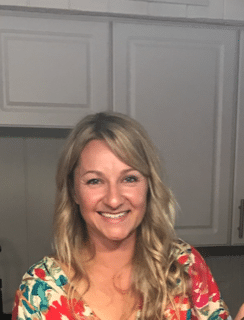What’s the Safest Boat you Can Buy?
If you’re in the market for a recreational boat and don’t know where to start, you’re in the right place. A few of the top consideration points when shopping for a new boat include length, floorplan, and safety.
During the shopping phase, there are a few different starting points depending on what your ideal day on the water is. First, what type of boat do you want? There are endless options but one of the main questions to start with is V-hull or pontoon boat.
You may be concerned solely about the size of the boat due to parking constraints or the size of your lake. Maybe your day on the water depends on the layout of the boat. For some, it’s the on-water activities that drive the boat type.
No matter what your top deciding factors are, safety is often considered in the initial shopping phase. Right off the bat, you may want to know what the safest boat on the market is. I’m going to break down what makes a safe vessel and help you find what’s right for your family.
The Safest Boat
When it comes to recreational boats, there’s not one size fits all when it comes to safety. What a family with four kids needs to be safe on the water may look different than what a couple with no kids needs.
Although similar, safety measures can and will vary depending on your situation. That said, the type of boat that is accessible to nearly all types of passengers is the pontoon boat. The way these boats are constructed makes them easy to board and steady in the water.
The toons keep the boat level, especially when boarding the boat. The flat deck makes loading and unloading children, pets, and anyone that has trouble with mobility much easier than say a V-hull.
Ease of boarding and accessibility for all make the challenge of boating much safer and possible for many that need a little extra caution around the water. Comparing this type of boat to a V-hull, a pontoon boat is the steadier option.
That’s because the hull on a V-hull is built so that the bottom of the “V” sits deeper into the water than the hull of a pontoon boat. Because of this, the V-hull is not as stable when entering and exiting the boat.
This also makes the floor of the boat deeper than the deck of a pontoon. Therefore, you have to step down into the boat. This is not a problem for those who are agile, but for many including pets, it’s much more of a challenge.
Pontoon boats are a safer option in many aspects beyond their stability in the water. The exterior rails that wrap around the entire boat keep everything inside. Think of lane bumpers at a bowling alley.
These rails are attached to the deck, wrap around the furniture, and are usually as tall as the furniture itself. This is a huge safety feature for everyone on board, especially children and pets that may become curious when they see the open water.
To take this a step further, there are countless layouts in the pontoon segment to choose from and some take safety to an even greater level. For example, the quad-lounge has rails that enclose even the stern.
With the gates closed, the entire boat is closed off from the water keeping everyone safely inside. There are lots of options like this, but from experience, Barletta owners that have small pets and/or children gravitate towards this floorplan for that reason.
Most boats don’t have the same structure which makes pontoon boats one of the safest options. That said, not everyone needs this type of setup. If it’s just you and your co-captain who can move about easily and knows to stay inside while underway, a V-hull may be the right choice for you.
Considered the SUV of the water, pontoon boats cover a lot of bases. They’re great for families and those who boat with their pets. They’re accessible to most people regardless of their mobility.
Nearly any type of boater will find a floorplan within the pontoon segment that fits their family’s needs. On top of that, today’s pontoon boats are more comfortable than ever and include tons of amenities that are built into the boat.
The old slow pontoon boats are a thing of the past. These new-age pontoons offer something for every type of boater. This leads us to the next safety consideration point. What about those who enjoy watersports?
Waterports
Let’s discuss the boaters that are avid watersports enthusiasts versus those who take the kids tubing every once in a while. Both can be done behind a pontoon boat, but should that be the case?
When it comes to watersports safety, the first thing you need to know is that you should never wakesurf behind any boat that has an outboard engine. This type of motor is attached to the back of the boat and the propeller juts out into the space where a wakesurfer would be.
This makes it extremely dangerous for anyone to be doing watersports near the back of the boat. Tubing, water skiing, and wakeboarding are different because these sports are performed far out from the rear of the boat.
If you’re looking to wakesurf, you should consider a tow boat. These boats have engines inside of the boat, called inboards, and the propeller is located underneath the hull, far from where someone would be able to reach it.
If you fall into the category of tubing with the kids every once in a while, a pontoon is still a great option. Even if you may ski or wakeboard now and then, pontoons will do the trick.
With the advancement in horsepower over the years, pontoon boats can have just as much torque as other power boats. That coupled with the tow boat style arch that many manufacturers offer make these boats more than capable of pulling a wakeboarder.

Safety should always be a priority when on the water, and it should be heightened when pulling someone behind the boat. I recommend considering what type of activities you plan to do with your boat and factoring that into the decision of the type of vessel you purchase.
Regardless of what kind of boat you land on, there is a standard of safety that’s driven by the U.S. Coast Guard and your local law enforcement. This includes safety features that are found on board most boats built these days.
Safety Features Built In
Most boat manufacturers are held to safety standards for each boat they build. For example, at Barletta, we are mandated to include safety information on the boat in a clear and easy-to-read area.
Informational stickers such as capacity ratings and fume emissions are placed strategically throughout every single boat. Other things such as fire extinguishers and emergency cut-off switches are mandated in many states and are typically built right into the boat.
Safety gear doesn’t stop there, many boaters forget that lighting also contributes to being a safe boater and in many cases, is enforced by law. When we design the anchor light that sits on top of the bimini, that light legally has to be set so many inches from the base.
This will keep you in compliance and help other boaters see you from afar at night. These are the built-in safety features that most boats should have straight from the factory.
If you’re purchasing a used boat, make sure you’re up to date on your local water laws, you may have to add some of these items to the vessel. Staying compliant will help to keep everyone on board safe and the boat on top of the water.
Don’t Sink
Sinking a boat is an extreme situation. It’s more rare than many realize but can be deadly especially if those on board don’t know how to swim or don’t have access to PFDs. The most common causes of sinking are boating accidents or hitting inanimate objects that are in the water.
There are a couple of boat types that are less prone to sinking because of the way they’re constructed. Although it is possible, it’s very difficult to sink a pontoon boat.
The only way to sink a pontoon is by water entering the tubes. In many cases, even if one tube fills with water, the other one or two will still keep the boat mostly afloat and you will likely be able to get it to shore without going down completely.
Another type of boat that stays afloat through nearly anything is a V-hull with foam core construction. One manufacturer, Boston Whaler, has taken this approach with their entire lineup. The foam core hull is so buoyant, they say you can cut it in half and it will stay afloat.
Other boats that don’t have these attributes have a greater probability of sinking when hitting an object and puncturing the hull. V-hulls can even go down if they take too much water over the bow.
As I said, sinking a recreational boat is possible but it doesn't happen just on a whim. No matter what type of boat you plan on buying, you should educate yourself on boater safety. And please, before you get behind the wheel, make sure you know how to drive a boat.
What Makes a Boat Safe?
If it’s a sound vessel to begin with, you are what makes the boat safe. Marine manufacturers are continuously held to safety standards that help them develop the safest boat possible.
With built-in safety features and the right type of boat, it’s up to you the owner to make sure safety measures are taken during every outing. I don’t care if you’ve been driving a car for 50 years, if you’ve never operated watercraft, take a class.
Most of the time, even your dealer will help you out and give you a lesson before you take the wheel. A smart boater is a safe boater, so please do yourself, your crew, and other boaters on the water a favor and stay educated on boating safety.



.png?width=700&height=300&name=build%20(3).png)